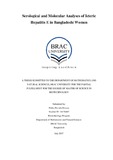| dc.contributor.advisor | Qadri, Firdausi | |
| dc.contributor.advisor | Choudhury, Naiyuum | |
| dc.contributor.advisor | Mannoor, Kaiissar | |
| dc.contributor.author | Biswas, Pritha Promita | |
| dc.date.accessioned | 2017-11-19T09:15:54Z | |
| dc.date.available | 2017-11-19T09:15:54Z | |
| dc.date.copyright | 2017 | |
| dc.date.issued | 2017-07 | |
| dc.identifier.other | ID 16176002 | |
| dc.identifier.uri | http://hdl.handle.net/10361/8515 | |
| dc.description | This thesis report is submitted in partial fulfillment of the requirement for the degree of M.Sc in Biotechnology, 2017. | en_US |
| dc.description | Includes bibliographical references (page 48-54). | |
| dc.description | Cataloged from PDF version of thesis report. | |
| dc.description.abstract | Bangladesh is an endemic zone for Hepatitis E Virus (HEV) which is associated with both
epidemic and sporadic infections. Since there have been few population-based studies of this
country’s HEV burden, its epidemiological characteristics and virological features remain
ambiguous. The study included a total of 30 female patients (13 pregnant and 17 nonpregnant
women) between the ages of 18 and 70 years, who were all representative of the
urban community in Dhaka city. All the subjects had visible jaundice and visited the
physicians within the study period (i.e. from August 2016 to May 2017). Clinical and
epidemiological data were collected from these patients using questionnaires and the
serology-based diagnoses of the Hepatitis viruses, as manifested by the levels of IgM and IgG
in case of Hepatitis A, C and E viruses and the presence of HBsAg in case of Hepatitis B
virus (HBV), were determined. Nucleic acids were isolated from the serologically positive
HEV samples and amplified with primers specific for the Open Reading Frame 2 (ORF2) of
the HEV genome in order to ascertain their HEV genotypes. Out of 30 patients, 29 were
serologically positive for HEV and 1 was positive for Hepatitis C Virus (HCV). Co-infections
of Hepatitis A Virus (HAV) and HEV and that of HBV and HEV were detected. Both
pregnant and non pregnant subjects had very high levels of serum bilirubin, Aspartate
transaminase (AST), Alanine transaminase (ALT) and Alkaline phosphatase (ALP), with no
significant difference in these levels between the HEV mono-infection and co-infection
states. Both anti-HEV IgM and IgG antibodies were detected in 51.7% of the HEV positive
patients while 41.4% and 6.9% of the patients were positive for only anti-HEV IgG and anti-
HEV IgM respectively. 15 out of 29 HEV samples were found positive for HEV RNA.
Sanger sequencing-based phylogenetic tree analysis of the HEV RNA positive samples
resulted in the formation of a single cluster within genotype 1. This is one of the very first
studies to report the clinical, epidemiological, and molecular characterization of an outbreak
of Hepatitis E in Bangladesh. | en_US |
| dc.description.statementofresponsibility | Pritha Promita Biswas | |
| dc.format.extent | 54 pages | |
| dc.language.iso | en | en_US |
| dc.publisher | BRAC University | en_US |
| dc.rights | BRAC University thesis are protected by copyright. They may be viewed from this source for any purpose, but reproduction or distribution in any format is prohibited without written permission. | |
| dc.subject | Hepatitis E | en_US |
| dc.subject | Women health | en_US |
| dc.subject | Virus infection | en_US |
| dc.subject | Bangladesh | en_US |
| dc.title | Serological and molecular analyses of icteric hepatitis E in Bangladeshi women | en_US |
| dc.type | Thesis | en_US |
| dc.contributor.department | Department of Mathematics and Natural Sciences, BRAC University | |
| dc.description.degree | M. Biotechnology | |

